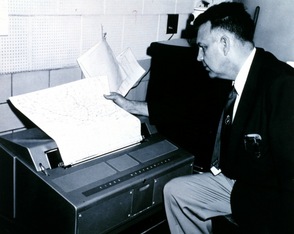PQUEUE - Printer Queue

The only printer in the computer science students' union is experiencing an extremely heavy workload. Sometimes there are a hundred jobs in the printer queue and you may have to wait for hours to get a single page of output.
Because some jobs are more important than others, the Hacker General has invented and implemented a simple priority system for the print job queue. Now, each job is assigned a priority between 1 and 9 (with 9 being the highest priority, and 1 being the lowest), and the printer operates as follows.
- The first job J in queue is taken from the queue.
- If there is some job in the queue with a higher priority than job J, then move J to the end of the queue without printing it.
- Otherwise, print job J (and do not put it back in the queue).
In this way, all those important muffin recipes that the Hacker General is printing get printed very quickly. Of course, those annoying term papers that others are printing may have to wait for quite some time to get printed, but that's life.
Your problem with the new policy is that it has become quite tricky to determine when your print job will actually be completed. You decide to write a program to figure this out. The program will be given the current queue (as a list of priorities) as well as the position of your job in the queue, and must then calculate how long it will take until your job is printed, assuming that no additional jobs will be added to the queue. To simplify matters, we assume that printing a job always takes exactly one minute, and that adding and removing jobs from the queue is instantaneous.
Input
One line with a positive integer: the number of test cases (at most 100). Then for each test case:
- One line with two integers n and m, where n is the number of jobs in the queue (1 ≤ n ≤ 100) and m is the position of your job (0 ≤ m ≤ n-1). The first position in the queue is number 0, the second is number 1, and so on.
- One line with n integers in the range 1 to 9, giving the priorities of the jobs in the queue. The first integer gives the priority of the first job, the second integer the priority of the second job, and so on.
Output
For each test case, print one line with a single integer; the number of minutes until your job is completely printed, assuming that no additional print jobs will arrive.
Example
Input: 3 1 0 5 4 2 1 2 3 4 6 0 1 1 9 1 1 1 Output: 1 2 5
hide comments
|
|
sk128:
2021-07-24 17:11:09
Used queue for the first time , enjoyed solving :) |
|
|
pawan_ks:
2020-10-08 09:22:10
just one pass throughout is required. hint-- keep a deque and a descending order set, print only when their first element match otherwise do circulation for deque:) Last edit: 2020-10-08 09:25:55 |
|
|
kumar_anubhav:
2020-06-08 22:27:25
A key concept of circular shifting is lit :)) |
|
|
luunguyen123:
2020-01-21 04:10:02
nice problem 1 |
|
|
sayan_244:
2019-12-17 07:33:48
used deque and array :p |
|
|
marethyu1:
2019-04-10 18:10:34
priority_queue and deque rocks! |
|
|
malcolm123_ssj:
2018-10-11 22:45:51
use stl c++ or python sl
|
|
|
spa1ish:
2018-05-02 19:37:10
AC.. using two vectors and sorting |
|
|
juancarlovieri:
2017-10-29 10:52:50
i've got wrong answer here :(
|
|
|
vincent_dj:
2017-09-23 10:15:23
The problem description is way too long and it would have been better if some unimportant details are deleted, or give highlights to the important details of the problem so that it is easier to spot them. |
| Added by: | overwise |
| Date: | 2007-10-02 |
| Time limit: | 1s |
| Source limit: | 50000B |
| Memory limit: | 1536MB |
| Cluster: | Cube (Intel G860) |
| Languages: | All except: ERL JS-RHINO NODEJS PERL6 VB.NET |
| Resource: | ACM ICPC NWERC 2006 |

 RSS
RSS